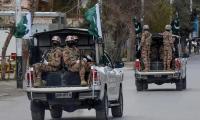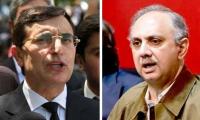In my previous column yesterday, I wrote about the two books that I bought at an unlikely place in Sindh – the Vanjara Café near Mirpurkhas. The first book, ‘As I saw it’, by G M Syed we have briefly discussed. In this column, Tahir Kamran’s book ‘Democracy and Governance in Pakistan’ is introduced to readers. With his weekly columns in the News on Sunday, Tahir Kamran enlightens his readers with new perspectives in history. His columns display a remarkable erudition not commonly found in newspapers.
As a professor of history, Kamran is one of the very few teachers and writers who have a critical eye to present objective analyses of various events, periods and personalities, especially those belonging to our recent past. If one wants to understand the recent history of Pakistan, the writings of Tahir Kamran provide a wealth of knowledge in an accessible manner. ‘Democracy and Governance in Pakistan’ was published by South Asia Partnership in 2008 but somehow it took me ten years to get it.
The main thrust of Kamran’s argument is that the root cause for the failure of democracy and lack of success in implementing an effective federalism is ‘ideological confusion’ that has repeatedly created obstacles in the way of democracy. The confusion started with the ‘Objectives Resolution approved in 1949, as it damaged the diversity of democracy and crushed any possibility of having a relatively secular dispensation as stipulated by Jinnah in his speech of August 11, 1947. Similarly, the use of concepts such as ‘Ummat’ and ‘Millat’ did not get along with the linguistic and nationalistic aspirations of the federating units.
The Muslim League had used Muslim identity as opposed to any other identity. The efforts to continue with Muslim nationalism rather than recognising diverse ethnic and linguistic preferences enhanced the ‘ideological confusion’. This resulted in perpetual political instability; and the authoritarian-dictatorial tendencies adopted by state institutions created alienation between the state and its citizens. A disproportionate emphasis on religious identity spawned fundamentalist and sectarian hatred in the country. The state response was to enhance political centralism and curb the expression of all cultural and political dissent.
According to Tahir Kamran, right from the beginning the use of executive powers by the governor-general reflected an extraordinary fault-line within the state structure that was supposed to be democratic – but never was. Ideally, the prime minister should have been the centre of executive powers but reliance on bureaucrats rather than politicians almost paralysed the office of the prime minister. This aberration facilitated the strengthening of non-political actors who prevented free and fair elections and also scuttled constitution-making.
A new constitution and general elections would have deprived the civil and military bureaucrats and high command of the vast powers they had monopolised. Kamran reminds us that the reins of the civil bureaucracy were held by Malik Ghulam Mohammad, Chaudhary Mohammad Ali, and Iskandar Mirza, and this triangle of bureaucrats joined hands with General Ayub Khan and prevailed throughout the decade of the 1950s. In books on history and politics, the first decade is termed as the ‘period of democracy’ or ‘parliamentary era’ – which is really a misnomer and contrary to facts.
In this discussion we must not ignore the role of feudal and landlords, mostly from the western wing of Pakistan, who joined hands with civil bureaucrats and the military high command to form an oligarchy. In this oligarchy, bureaucrats were much more powerful. With Ayub Khan taking over in 1958, the relationship between the civil and military bureaucracy changed and within the non-political class the army held sway; but they continued their cooperation, whereas the politician had to face much more difficult times. Thousands of politicians were barred from political activities via the Elective Bodies Disqualification Order (Ebdo).
General Ayub Khan used the system of Basic Democracies (BDs) to perpetuate his own rule. The 1962 constitution was formed in such a way that – in the words of Justice Rustom Kayani – General Ayub Khan became the clock tower of Lyallpur, where all roads converged. When Fatima Jinnah was contesting elections in 1965, the good general unabashedly used the state machinery and took full advantage of media and newspapers as official loudspeakers. He almost eliminated left-wing politics in the country, which had a harmful impact on the democratic and political processes.
From there Tahir Kamran takes us to analysing the role of the judiciary in the country. He says that all dictators – civilian or military – need a judiciary that is compliant and supple. The ‘theory of necessity’ is such a damaging blot in the political history of Pakistan that does not show the judiciary as independent and people-friendly. From Justice Mohammad Munir to Justice Irshad Hassan Khan, judges have approved and verified usurpations. At the cost of the constitution, authoritarian rule was justified.
There were of course some exceptions. For example, Kamran cites Justice Rustom Kayani, Justice Cornelius and Justice Iftikhar Chaudhry. But most of the judges felt no compunctions while taking oath under the various PCOs (Provisional Constitutional Orders) enforced by dictators. The book also discusses the importance of the political and social roles played by religion in the history of Pakistan. In a modern state structure if you keep enhancing the importance of religion, it only creates further ideological ambiguities. Kamran thinks that Pakistan was originally conceived as a nation-state but it was molded into an ‘ideological state’.
Gradually, democracy has become subservient and even scientific innovation and thinking have been sacrificed. Traditional practices have been solidified, as became evident when Maulana Rasheed Ghazi in Lal Masjid and Fazlullah in Swat were initially provided with resources that ultimately helped them challenge the supremacy of the state itself. An incessant propagation of the idea that Pakistan was created in the name of religion has allowed religious leaders to preach and promote their own medieval concepts and ideas. All ‘un-Islamic’ acts could be eliminated with force, which is how democratic traditions and values were negated.
Another commonly held misconception that Tahir Kamran clarifies is the idea that Deobandi religious leaders had opposed the creation of a separate homeland for Muslims. Actually, Deobandi leaders were divided into two streams of thought. Abul Kalam Azad and Hussain Ahmad Madni were opposed to the idea of Pakistan, but Shabbir Ahmad Usmani, Zafar Ahmad Usmani, Mufti Muhammad Shafi, Khair Muhammad Jalandhari and their predecessor, Ashraf Thanvi, all supported the creation of Pakistan. Kamran highlights the fact that the help given by the Kingdom of Saudi Arabia (KSA) enhanced the economic resources of religious parties manifold.
This book is a unique source of analysis in Urdu that must be read by all those who want to understand the power dynamics of the country and see how over the decades an interplay between authoritarianism and religion has transformed Pakistan into a hotbed of religious strife and intolerance. No sensible person can disagree with Tahir Kamran when he says that for the promotion of civil society, freedom of expression is vital. Diverse political and social units can survive only in an enabling and conducive atmosphere.
Concluded
The writer holds a PhD from theUniversity of Birmingham, UK and works in Islamabad.
Email: mnazir1964@yahoo.co.uk
MPAs ask for their salaries and benefits to be at par with high court judges and exempt from tax
This system fosters and places premium on VIPs, facilitating VIP culture, which is alive and kicking
Imagine this waste covering over 15,500 cricket stadiums, piled three meters deep every year
If there is one thing that can be gleaned from politics today, it is that we no longer speak same language
Postman argues that “typographic mind” was yielding to “televisual mind”
Pakistan is well poised to meet opportunities that Artificial Intelligence will offer for developments in industries







